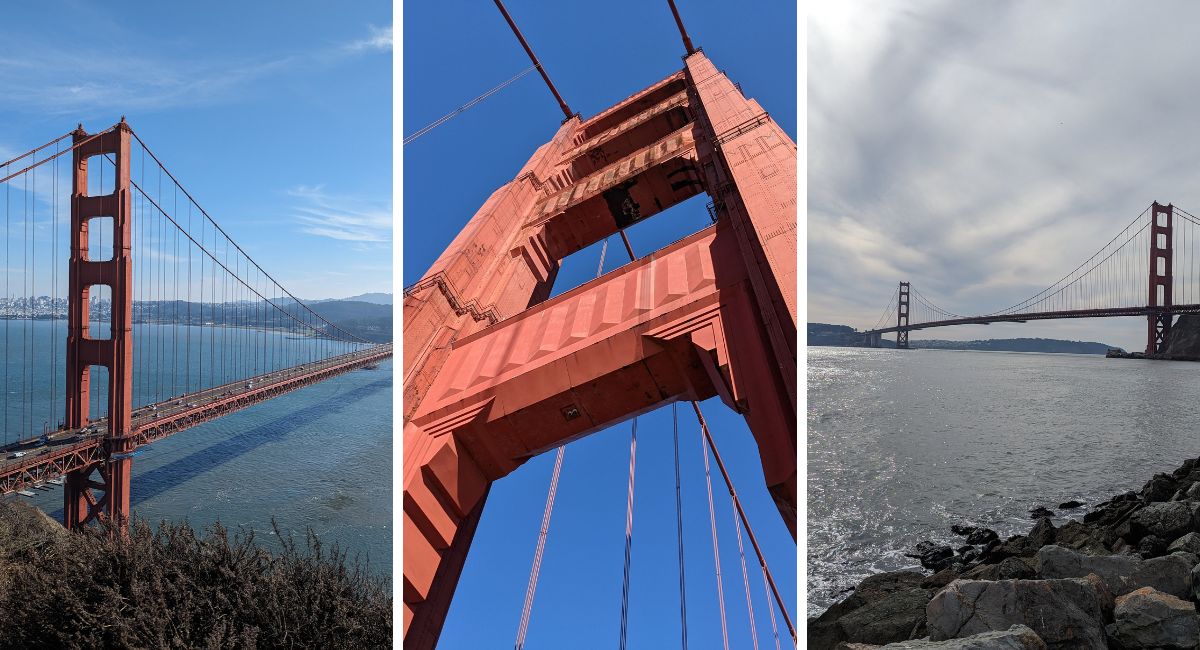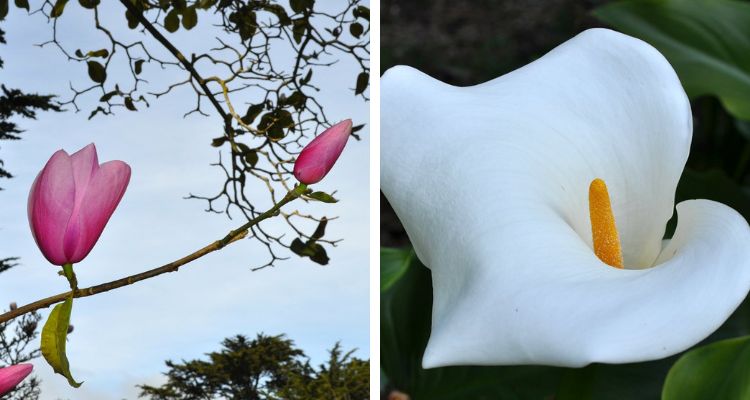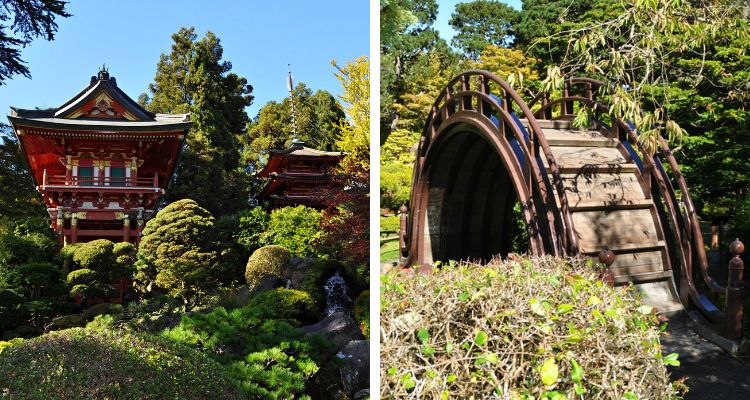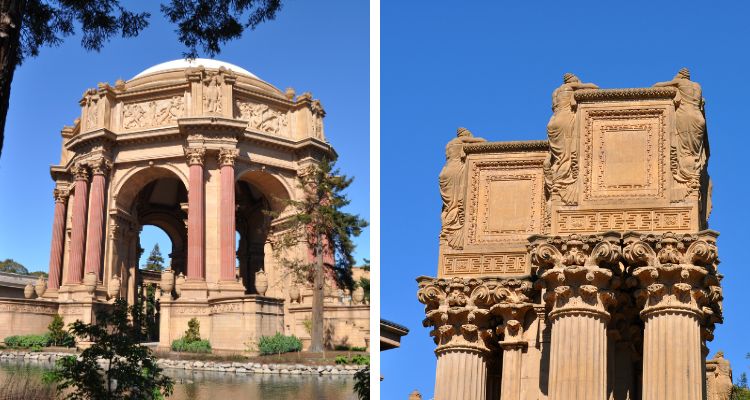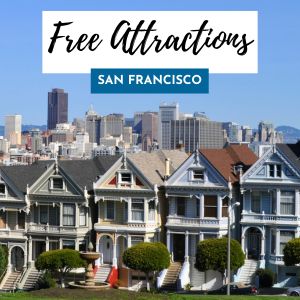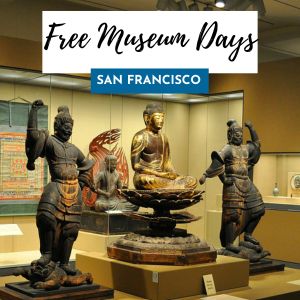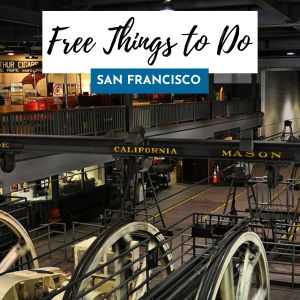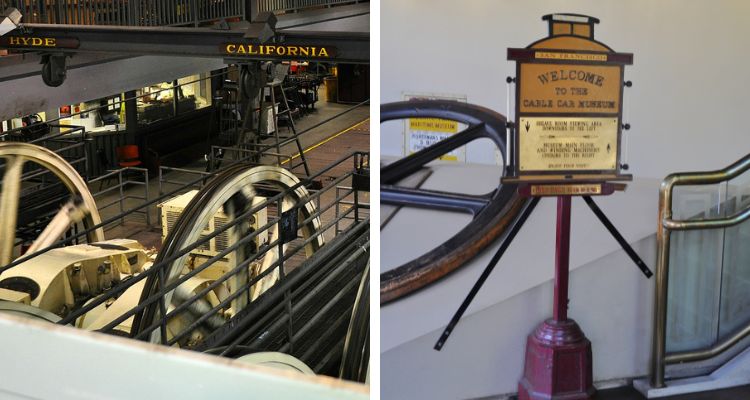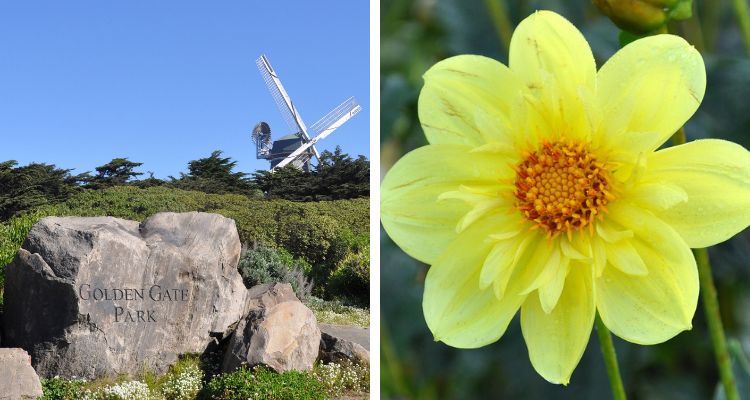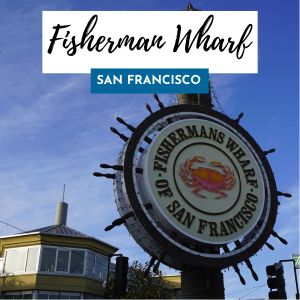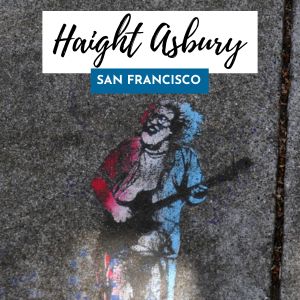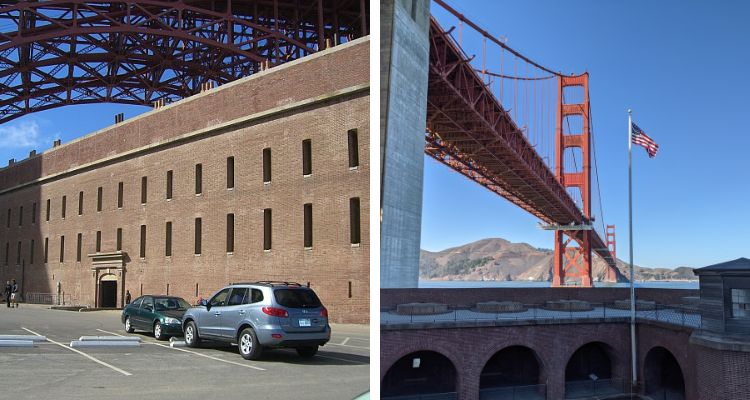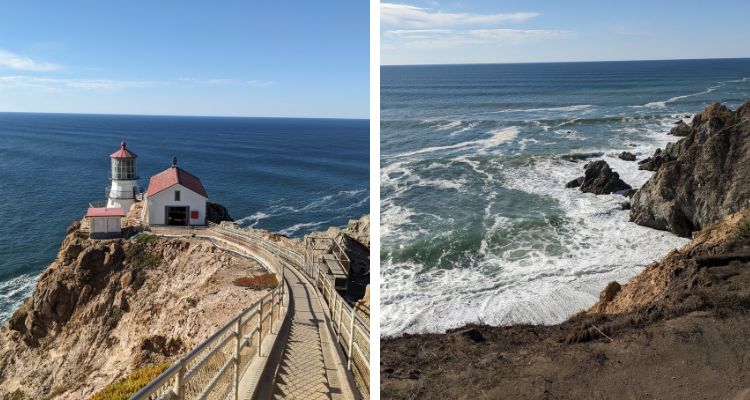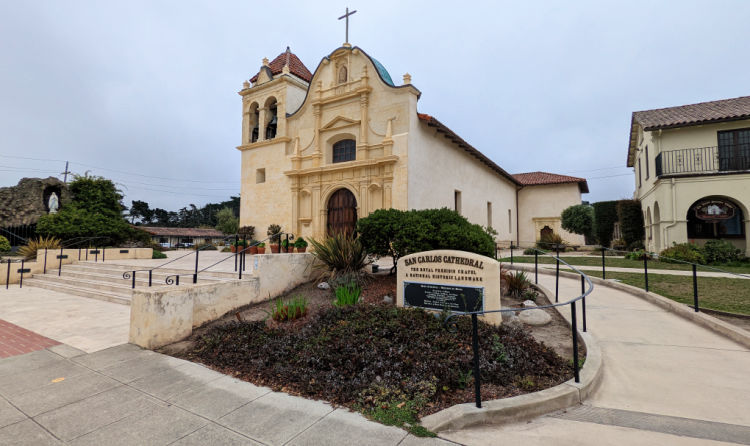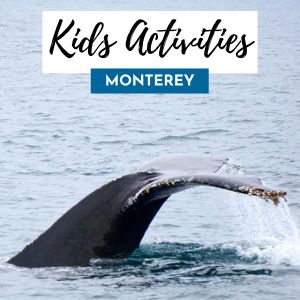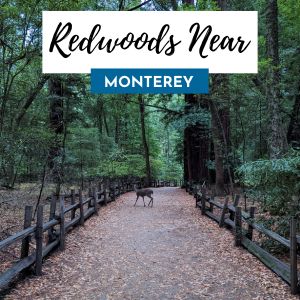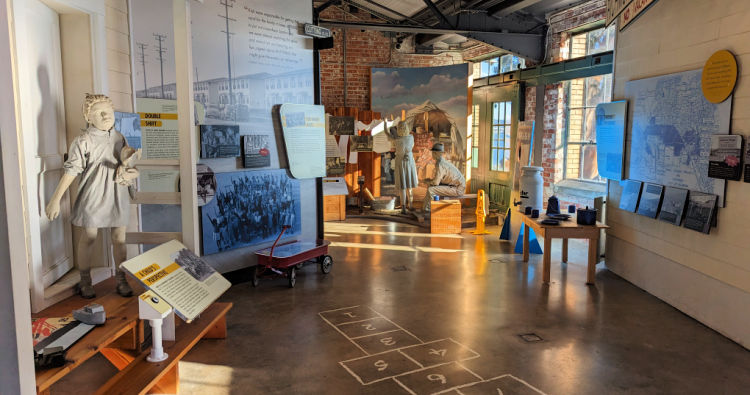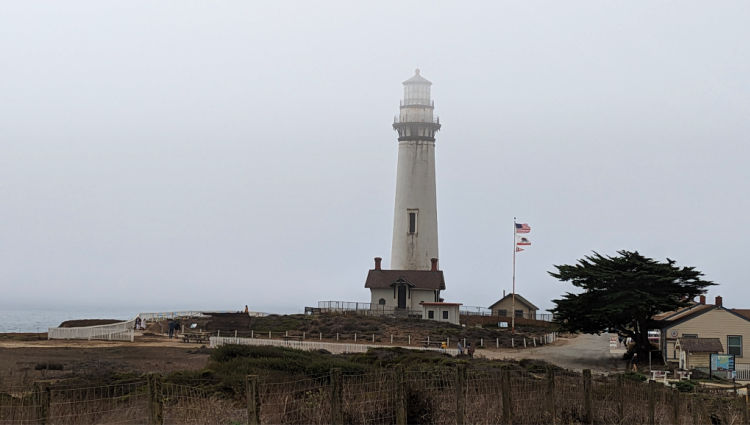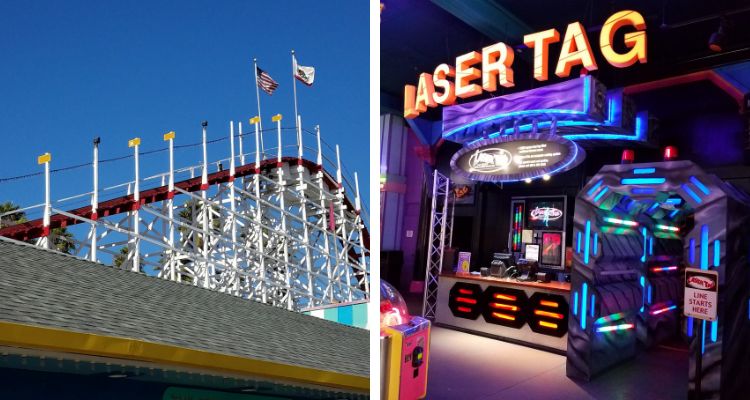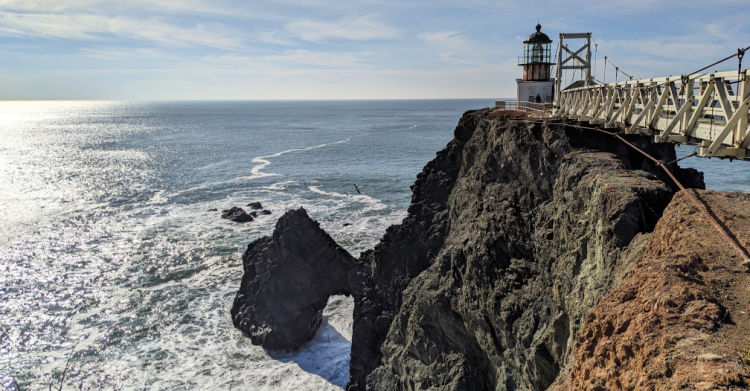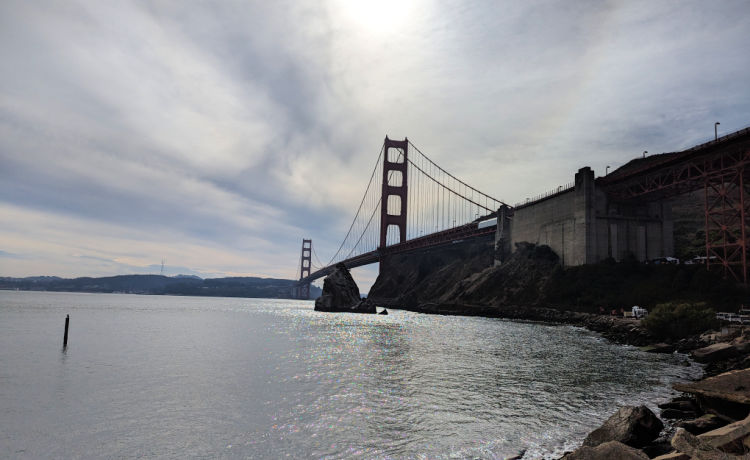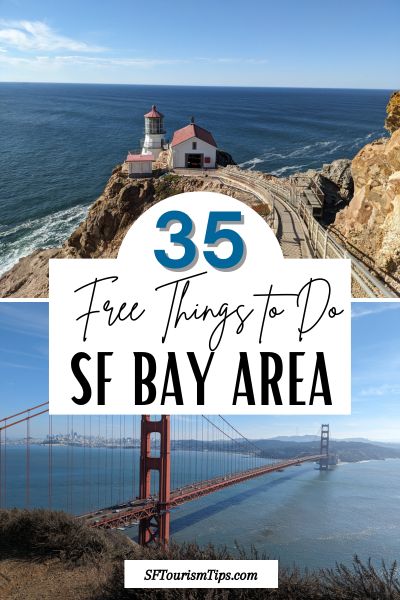SIGN UP FOR MY EMAIL TO RECEIVE YOUR FREE SAN FRANCISCO PLANNING GUIDE.
- Home
- Free Things to Do in the Bay
Free Things to Do in the Bay Area: 35 Fun Finds
By: Jill Loeffler • Updated: February 27, 2025 • Published: March 14, 2024
Are you looking for some free things to do in the Bay Area? My guide offers details about the best budget-friendly ideas from San Francisco to Monterey and beyond!
My recommendations include the top free attractions, museums, and other points of interest. My top picks include the Golden Gate Bridge, the John Muir National Historic Site, and San Carlos Cathedral.
You will also find some great ideas in Marin County, the East Bay, and around the Peninsula.
SFTourismTips is made possible by readers like you! If you book through my links, I may earn a small commission—at no extra cost to you. Thanks for your support! Learn more.
1. Golden Gate Bridge
The Golden Gate Bridge is a one-of-a-kind world-famous landmark you must visit when in San Francisco. A sightseeing cliché it may be, but the sheer magnificence of the structure needs to be seen up close.
I like to start with a visit to the Welcome Center and learn the story of the Bridge and the impressive engineering behind it. I find it's a great way to follow the history of its construction and maintenance with its outdoor interactive exhibits.
If you want a full guided tour, then I recommend checking out the free walking tours available two days a week. These are hosted by San Francisco City Guides, part of the SF Library.
I've done this tour a few times, and the guide typically walks all the way to the first tower as they tell you all about the bridge.
No trip to San Francisco is complete without a visit to the Golden Gate Bridge.
>> More about visiting the Golden Gate Bridge
>> Tips to walk across the bridge
2. Marin Headlands
Unique and often mysterious, the Marin Headlands sit along the southern coast of Marin County and are easy to access from San Francisco. They are an important site of biological diversity and offer beautiful views of the Golden Gate Bridge.
Some of my favorite places to soak in the views from the northern end of the bridge are Vista Point and Battery Spencer.
In addition to checking out the views of the Golden Gate Bridge, I love to experience this area by going on a hike, visiting the Point Bonita Lighthouse, and relaxing at one of its secluded beaches.
This is a great place to visit to take a break from the bustling city and enjoy the views.
3. San Francisco Botanical Garden
Located in Golden Gate Park is the San Francisco Botanical Garden, home to one of the most fantastic plant collections anywhere.
The established gardens allow visitors to see an incredible selection of plants from around the world, as well as those native to Northern California and the San Francisco Bay Area, with an ever-changing selection through the different seasons.
My tip, if you want to visit for free, is to arrive between 7:30 and 9 am. Everyone gets in free in the first 90 minutes after they open.
You can also get in free on any major holiday. The other way to visit for free is to visit on the second Tuesday of the month.
When you visit, make sure to look for plants from as far afield as Australia, New Zealand, and South East Asia, and marvel at the magnificent array of colors that the garden displays.
One of my favorite times to visit is from mid-January to mid-March when their Magnolia trees are in full bloom.
Their pink flowers are a magnificent site. I want to note that their peak bloom changes each year, but you can usually see some of them during this time frame.
For lovers of flowers and horticulture, this is a unique opportunity to explore what I think is one of the best botanical gardens in the world!
>> Tips to visit the San Francisco Botanical Garden
4. Custom House Museum in Monterey
The Old Custom House Museum in Monterey is a genuinely fascinating free museum housed in a building rich in the history of the region and state.
Monterey, the original capital of California, played a large part in developing the greater San Francisco Bay Area.
I enjoy learning about the historical changes that the Custom House has witnessed as a National Historic Landmark—from the influence of the Spanish settlers and the Mexicans who were instrumental in developing the region to the important role this region played in the creation of the United States.
With many interesting artifacts inside Custom House, I recommend you look around Monterey for examples of 19th-century houses built by the Spanish and Mexican inhabitants.
>> More free SF Bay Area museums
5. Japanese Tea Garden
I think there is something truly remarkable about the San Francisco Japanese Tea Garden.
Initially created as a showcase for a major exhibition in 1894, the building now stands as a testament to its creator, Japanese landscape architect Makoto Hagiwara, who lived here with his family until 1942.
Today, the Japanese Tea Garden offers a slice of traditional Japanese tranquility within Golden Gate Park and is among the most popular tourist attractions in San Francisco.
This attraction isn't free all the time, but you can visit for free when you arrive on Mondays, Wednesdays, and Fridays between 9 and 10 am!
It's one of my favorite secrets to visit this gem without having to pay for admission.
>> More about visiting the Japanese Tea Garden
>> More things to see and do in Golden Gate Park
6. Monarch Grove Butterfly Sanctuary
One of the most spectacular natural sights in the San Francisco Bay Area is the arrival of thousands of Monarch Butterflies that migrate to the Monarch Grove Butterfly Sanctuary to spend the winter in warmer climes.
They arrive from colder regions in October—a mass of color and movement—and the sanctuary at Pacific Grove is among the most impressive places of all to witness this.
There are several remarkable factors about the Monarch migration. They head to the California coast between Canada and Mexico and may fly as many as 2000 miles to reach Pacific Grove.
Perhaps most remarkable is that the butterflies that arrive each year have never made the migration before, since a female Monarch only has a six-week lifespan.
How do they know where to go? That's one of the true wonders of nature, so don't miss this fantastic experience.
>> More free things to do around Monterey
7. Palace of Fine Arts
If you want to combine completely free things to do in the Bay Area with a touch of culture, I recommend you check out the Palace of Fine Arts.
It was built as part of the Panama-Pacific International Exposition in 1915 as a way to show San Francisco was back on the map after the devastating 1906 earthquake.
On your visit, you can check out the gorgeous classical dome and columns. It's also a great place for a picnic while you admire the architecture reflected in its lagoon.
The Palace of Fine Arts is completely outdoors and a perfect free SF attraction to visit during your stay.
>> Tips to visit the Palace of Fine Arts
8. Mount Tamalpais State Park
Open seven days a week from 7 am to sunset all year round, Mount Tamalpais State Park is famous for its wildflowers and walking trails that will take you through the magnificent wilderness.
You'll find the Redwood Violets and Redwood Sorrels along the forest trails while the California poppies abound in a beautiful splash of color in the grassland area. The flowers are most brilliant in the spring and early summer, which is my favorite time to hike here.
Other top things to do here include checking out the redwoods, enjoying a bike ride, and camping for the night.
Mount Tamalpais is located in Marin, just north of the Golden Gate Bridge.
>> Visit the CA Parks site to learn more and check for hiking trail details
9. Painted Ladies of Alamo Square
The famous Painted Ladies of Alamo Square have achieved iconic status among San Francisco landmarks. Also referred to as the 'Seven Sisters,' this group of seven similarly designed and painted houses are privately owned residences.
My recommendation is to head into Alamo Park, where you can get a sweeping view of downtown San Francisco behind them. It makes for the perfect picture of your visit to San Francisco.
The Painted Ladies, a term now applied to Victorian and Edwardian properties that have been restored and decorated in the proper color, date from the late 19th century, and those of Alamo Square—the most famous of all—are picture postcard perfect.
Insider Tip: Even though these are private residents, the owner of the blue one is currently offering a tour of their house. You can learn more about this tour here.
>> More about the history and some visiting tips for these gorgeous historical gems in San Francisco
10. Lake Merritt
Across the bay, in the center of Oakland, California, sits Lake Merritt, a beautiful human-made lake set in a stunning park.
The lake features a diverse program of events throughout the year, many celebrating the multi-cultural nature of Oakland, and is the oldest designated wildlife refuge in the USA, granted this status in 1870.
Today, the lakeside is popular for dog walkers to meet other dog walkers, while skaters and rollerbladers use the Sailboat House parking lot as a meeting point.
The lake is popular with bird spotters thanks to the many species of water birds, as well as for boating, running, and biking.
There are various sporting facilities and more within the park.
I love to enjoy Lake Merritt by grabbing a bite to eat at their Lake Chalet Seafood Bar & Grill.
>> More about visiting Lake Merritt
11. Cable Car Museum
San Francisco's famous cable cars have been serving the city since 1873. The Cable Car Museum is the place to learn about the history of these fascinating vehicles, which still run on the streets of San Francisco today.
Located within the Washington-Mason Powerhouse and Car Barn on Mason and Washington Streets, you will see a collection of historic cable cars, engineering artifacts, and items that tell the fascinating story of the inventor and the development of the network right up to the present.
One of my favorite parts of the museum is watching the cables in action. You can watch them as they spin to pull the active cable cars around San Francisco.
This informative museum is free to enter and covers the important story of a San Francisco icon. Make sure to ride on a cable car once you've visited the Cable Car Museum to complete your experience.
Kids will love it.
>> More about visiting the Cable Car Museum
>> More great free museums in San Francisco
12. Reinhardt Redwood Regional Park
Dr. Aurelia Reinhardt Redwood Regional Park was recently renamed after the good doctor who was among the first Directors of the Park District when it was formed in 1934.
The park is a beautiful place with more than 1800 acres to explore and many trails meandering through the wonderful redwood forests. Once a bustling logging region, the planting of 150 Coast Redwoods gave it back its forest nature.
Now, it is home to many rare species of plants and animals, including the magnificent Golden Eagle. Redwood Creek is where the first Rainbow Trout were caught and named.
There are two picnic areas within the park that are wheelchair friendly.
While this park is free most of the time, it does collect fees on weekends and major holidays between April and October.
This is only for those entering through the Redwood Gate entrance.
13. Free Walking Tours with SF City Guides
San Francisco is one of the world's most exciting cities, and the best way to get to know this diverse, colorful, and friendly metropolis is to take one of the free walking tours offered across the city.
A team of 300 volunteer tour guides, each of whom knows their route intimately, offers 80 unique tours of parts of San Francisco. I always learn something new about the history and culture of San Francisco when I take these!
They often test out new tours in April and October, so these two months offer quite a few extra tours.
>> Find out more about these informative free walking tours
14. Charles Lee Tilden Regional Park
One of the many fine parks in the San Francisco Bay Area is Charles Lee Tilden Regional Park in the Berkeley Hills. With many attractions aimed at the younger generations, this park makes a great day out for a family.
Top free picks here include hiking, its Botanic Garden, and the Tilden Nature Area, which includes the Environmental Education Center and the Little Farm.
If you have a little money to spend, you can check out the Steam Train, which takes you on a fun ride around the park, or the Merry-Go-Round, a magnificent working antique carousel. There is a small fee for both of these attractions.
You will find Charles Lee Tilden Regional Park in the Berkeley Hills in the East Bay.
15. Stern Grove Festival
If live music is your thing, check out the Stern Grove Festival, which has been bringing free live concerts to San Francisco since 1938! This annual festival runs from mid-June to mid-August, with concerts every Sunday at 2 pm.
I find it unbelievable that this festival is free at times when I see their annual line-up. You will find big names such as the Indigo Girls, Lyle Lovett, and Boz Scaggs.
You will need to book your seats online in advance, and when you arrive, seats are first-come, first-served for anyone who arrives with a ticket.
You will find this festival at Sigmund Stern Recreation Grove at 19th Avenue and Sloat Boulevard.
>> Find out more about this year's festival
16. Cathedral Basilica of St. Joseph in San Jose
The spectacular Cathedral Basilica of St. Joseph in San Jose will interest worshippers and anyone who digs historical sites and architecture. The original church on the site was built in 1803 but was damaged by earthquakes.
Three further churches were built on the site, one damaged by an earthquake, another destroyed by fire, and the other temporary. The current basilica was begun in 1875 and completed 10 years later.
A significant renovation of this historic building was undertaken in 1981, and the church was given cathedral status in 1985.
The Cathedral Basilica is a fascinating building with an exciting history and is listed on the National Register of Historic Places and is a designated California Historical Landmark.
17. Golden Gate Park
The famous Golden Gate Park is 1000-plus acres of wonderful things to do and see. It has everything you could wish for in a family day out or simply as somewhere to spend time and relax.
With fishing and boating lakes, beautiful gardens and groves, museums, and historic buildings, this park is for everyone, and a friendly and warm welcome is always present.
Entrance to the park is free. Other free things to do here include strolling around Blue Heron Lake (formerly called Stow Lake), checking out the small bison herd in the Bison Paddock, and smelling the roses in the Rose Garden.
You can also check out the Dahlia Dell near the Conservatory of Flowers, the National AIDS Memorial Grove, and the Koret Children's Playground for free.
You will find numerous other things to do here, but some of the biggest attractions require paid admission.
>> Find out more about the best things to see and do in Golden Gate Park
18. Japanese Friendship Garden in San Jose
Right in the center of the busy city of San Jose is a place of peace and tranquility: the Japanese Friendship Garden. This magnificent feature combines the beauty of traditional Japanese gardens with Koi ponds and various species of wildlife.
When you come with your picnic or to take a stroll around the garden, look for the egrets that frequent the ponds. You'll also find a fully operating venue that is often used for weddings and other celebrations.
Primarily this serene spot acts as a place where locals and tourists can take some time out from the city amidst the beauty and calm of nature at its finest.
If you are visiting as a family, there are frequent events held here that cater to kids.
>> More tips for visiting and their upcoming event schedule
19. Missions Murals
San Francisco is famous for its diverse multi-cultural society, and one of the best free ways to appreciate this is by observing the more than 1000 colorful and powerful murals that decorate the city.
The Mission District has the biggest concentration of murals—and some say the best. This is not regular graffiti. It is first-class public art.
San Francisco's murals are managed and protected, and it is not unusual for a business or individual to request a mural on their building.
Balmy Street was the scene of the first Mission Mural in the early 1970s, and today, most buildings on the street feature impressive artwork.
If you want a more in-depth understanding of the Balmy Street works, I recommend you book one of the Free Walking Tours, where a knowledgeable guide will tell you the stories behind them.
>> My tips to visit the Mission Murals
20. University of California Museum of Paleontology
The Museum of Paleontology in Berkeley contains one of the world's most impressive collections of fossils and dinosaur artifacts. You'll find it in the Valley Life Sciences Building on the University of California, Berkeley campus.
Kids will love the T-Rex, the collection's centerpiece, and the Triceratops skull. My favorite is the magnificent Pteranodon, a flying beast with a 22-foot wingspan, spectacularly suspended above the visitor gallery.
The collection on public display—most of which are plaster casts of originals kept in storage—represents just a tiny percentage of the complete collection.
It's an exciting and educational experience for all.
These exhibits are free for viewing during the building's regular hours.
Beyond that, this museum is an important research center and the state repository for fossils found in California.
>> Learn more on their official site
21. Fort Point National Historic Site
The historical importance of Fort Point cannot be overstated. This former fort defended San Francisco starting from the days of the Gold Rush and is an important reminder of the era's impact on forming California as it is today.
The fort is a fascinating building and overlooks the most famous landmark in the Bay Area, the Golden Gate Bridge.
I enjoy photographing the bridge from the top floor of the fort, where you can get an excellent look at this famous structure. Another plus is that children will enjoy the fort as much as adults.
>> Find my tips to visit and pictures from my recent visits
22. Magnes Museum at UC Berkeley
The Jewish community in San Francisco and elsewhere in this part of California has played a prominent role in shaping this multicultural and diverse region.
The Magnes Museum at UC Berkeley tells the story of the Jewish settlers through an impressive collection of art and artifacts relating to Jewish history and culture.
The museum includes reminders of some of the more tragic events in the history of the Jewish people, so be prepared for exhibits that may shock but are an essential part of history.
There are some wonderful and vital pieces of art at the Magnus Museum, and while it is geared toward the adult visitor, it is still worth a visit no matter your age, if you are interested in history.
>> Visit their site to learn more
23. Point Reyes National Seashore
This part of the California coast is cherished by locals and visited by many thousands of tourists every year.
Many of them head for Point Reyes National Seashore, a managed coastal park with miles of beautiful beaches, grassland habitats, and dramatic rocky headlands just north of the San Francisco Bay Area.
If you want to learn a little more before you start your visit, I recommend stopping by one of their three visitor centers. The main one at the entrance is open all year, and the other two are open only on certain days or times of the year.
The main visitors center is where you will find rangers who can help answer your questions or help you plan your day, maps and guides to the park, or souvenirs to help you remember your visit.
The main visitors center also features some free exhibits so you can learn more about the park either before or after your visit.
With more than 1500 species of plants and wildlife within the park, there is plenty for nature lovers to enjoy.
24. John Muir National Historic Site
John Muir was an essential figure in the early days of the conservation movement, and the John Muir National Historic Site is a memorial to perhaps America's greatest naturalist.
Learn how Muir convinced the US government to place protection orders on some of California's most important historic sites and take a guided tour to view the artifacts relating to his interesting and rewarding life.
Examples of his important and groundbreaking writings form part of the collection, while the park is home to a vast and diverse selection of wildlife, including some rare and endangered species.
This is a beautiful place to spend a few hours at one with nature and learning about a great man.
>> Visit the NPS site to learn more
25. San Carlos Cathedral
A fascinating history lesson awaits at San Carlos Cathedral in Monterey. The oldest building in Monterey is also the longest-serving church in California, dating back to the first service in 1770!
An attractive building, it was one of four such in the city and is now the only one remaining.
There are many interesting facts about the Cathedral, one being that it was the first building in California to be designed by an architect and another that it was the first building in the state to be built from cut stone.
The current building dates from 1794, and a recent archaeological dig on the site discovered many interesting old items that help tell the story of the smallest Cathedral in the continental United States.
When I visit, I typically spend about an hour here.
>> Visit their official site to learn more
26. Rosie the Riveter WII Home Front
The work of civilians in World War II era America is often overlooked. During the war, Rosie the Riveter symbolized the many women who took on roles that were vital to the war effort.
This WWII Home Front National Historical Park tells the story of those forgotten people.
I find it's a treat to listen to the stories of real women who worked on the Home Front. You can also explore the many exhibits and interactive features this park and museum offers.
When you arrive, I recommend checking out the list of movies they have playing that day. Each one offers a deeper dive into one part of the history of this time.
27. Pigeon Point Light Station & Lighthouse
The stunning sight of Pigeon Point Light Station, perched high on the cliff where it has been since 1872, is a view to behold.
One of the tallest such structures in America, it is named after a ship called "The Carrier Pigeon," which ran aground here with all hands thankfully surviving.
Today, this National Historic Landmark, just 50 miles south of San Francisco, is an easy stop along Highway 1 near the quaint town of Pescadero.
Visitors can learn about the history of the building, and if nature is your thing, this site is an excellent place for birdwatching.
While you can't currently step inside the lighthouse, you can learn more about this gem in the visitors center and park store. During my last visit, they had quite a bit of information about the future plans for this lighthouse and how they plan to one day reopen the entire thing to the public.
28. Eugene O'Neill National Historic Site
Eugene O'Neill is the only American playwright to win the Nobel Prize for literature. He chose to live in this beautiful house, the Tao House in Danville, for most of his writing career, and today it stands as a memorial to a great wordsmith.
Visitors to the home can learn about O'Neill's fascinating life and see where he worked long hours putting together famous tales such as "The Iceman Cometh."
It's an intriguing and interesting museum, and I find that the gardens are a delight. With much of the house preserved as it was when he lived and worked here, this is an important landmark for lovers of literature and American history.
>> More about visiting on the National Parks Service website
29. Santa Cruz Beach Boardwalk
There are few historic sites more famous in the greater Bay Area than the Santa Cruz Beach Boardwalk. First opened in 1907, the Boardwalk remains the oldest amusement park in California, and is designated a California Historical Landmark.
It's free to walk along the Boardwalk and check out all the activities, but there is a cost associated with the rides and other games.
Two of the most famous rides, the Big Dipper and the Looff Carousel, are listed on the National Historic Landmarks Register. I enjoyed the exhibition of photographs showing the boardwalk through the ages, which gave me great insight into how it has developed.
Kids and adults alike will love both the vintage and more modern rides and amusements, and there are plenty of food outlets within the park.
Visitors to Santa Cruz must set aside a day to visit Santa Cruz Boardwalk as it is a unique experience and open for the public to walk around
>> Visit their official site for hours and more details
30. San Francisco Bay Model
The San Francisco Bay Model is something of a hidden gem. This fully working and intricate model of San Francisco Bay and the Sacramento-San Joaquin River Delta System is an engineering marvel.
It is tended and operated by the U.S. Army Corps of Engineers. I find this unique attraction is a great stop for both adults and children, and group tours are available if booked in advance.
The tours are tailored to the level of technical understanding of the visitors to ensure that everyone, including younger children, can learn all about the model itself and the Bay System.
Few other attractions in California are guaranteed to amaze, and the history and purpose of the model make for a fascinating story.
Don't miss this if you love models or if you are interested in the engineering aspect.
>> See pictures and learn more about visiting
31. Point Bonita Lighthouse
Located in the Golden Gate National Recreation Area just north of the Golden Gate Bridge is Point Bonita Lighthouse.
This remarkable building has protected sailors in the treacherous Golden Gate Strait since 1855, and today is still a working lighthouse and as crucial as ever.
A visit here includes learning about the history of the building and the geology of the region.
I do want to warn you though that it does take a little effort to get here from the parking lot. The trail is steep and is about a half mile long.
I also don't love heights and to visit the lighthouse, you do have to walk across a bridge that connects the landing with the lighthouse. There is a huge drop below to the water, but I found the bridge is very well maintained and stable, so it didn't cause me much concern when I just focused on looking ahead (and now down!).
Because of how exposed the bridge is, the lighthouse will sometimes close down if it's too windy in the area.
The lighthouse is mainly open every Friday - Monday just for a few hours.
32. Fort Baker
Fort Baker, a former U.S. Army Post dating from 1925, is also located within the Golden Gate National Recreation Area. With 25 historic ex-army buildings on the site and many historic gun emplacements, this is a fun place to explore on your own.
When you visit, you can learn about the fort's history and the roles it has played over the years.
Apart from the historic attraction, there is plenty to do and see here, including activities like fishing, no-license-required boating, and easy walking and hiking trails.
One of my favorite things to do here is to soak in the views of the Golden Gate Bridge. There are so many great places here to admire it that I sometimes will spend hours here just enjoying it.
>> More about visiting Fort Baker
33. Pleasanton Museum on Main
Pleasanton is an idyllic city located in the rolling hills of the Amador Valley, just 45 minutes east of San Francisco.
The Museum on Main is a great place to take your kids as there is a dedicated area with plenty for them to enjoy.
The museum also has a permanent collection of art and artifacts, as well as special exhibitions for a limited time, so it is worth checking the website and calendar to find the ones that interest you.
The one I find the most fascinating is "Growing Pleasanton." It's a permanent exhibition charting the history and development of the region, beginning with the Ohlone Tribes, the indigenous people who originally lived on this land. It features information all the way up to today's city of Pleasanton.
This enjoyable free museum takes visitors on an enchanting and educational journey.
>> Visit their site to learn more
34. South Bay Historical Railroad Society
The importance of the railroads in making California the state it is today cannot be overlooked. The railways brought people to the region. It also made transporting goods around the state much easier.
Today, the South Bay Historical Railroad Society in Santa Clara offers a wonderful exhibition that tells the story of the railroads in the region and their part in important eras such as the Gold Rush.
The collection, which includes vintage railcars, is housed in a historic depot building that has been lovingly restored and preserved and dates from 1863.
Children and adults will appreciate the two superbly created model railway layouts that depict various elements of the network in the region.
Be aware the depot is only open to the public on Tuesday evenings and Saturdays from 10 am.
>> Visit their site to learn more
35. Los Altos History Museum
Los Altos began as an agricultural town and is now a small, affluent city 45 minutes south of San Francisco. The Los Altos History Museum should be on every history lover's list of places to visit in California.
It has both permanent and changing exhibitions, but it is best known for the fascinating J. Gilbert Smith House, which was built by Smith in the first decade of the 20th century.
He lived here until he died in 1973, although the city had purchased the house and land in 1954, granting the Smiths permanent residence. Today, the house is a reminder of the typical farmhouse properties that were once prevalent in the Los Altos region and is kept as it would have been in the period.
The gardens and agricultural exhibits are also of great interest.
>> Visit their site to learn more
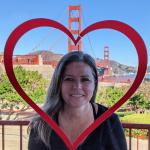
Hi, I'm Jill!
Dreaming of a San Francisco vacation? As a proud local, I'm here to share my insider tips and personal experiences to help you make the most of this iconic city!
Comments? Questions? Suggestions?
I would love for you to join me in my private Facebook group!
It's a great place to interact with me and others who know the area well.
You can ask questions, get advice for your upcoming stay, and then share your photos and advice with others when you return home. It's a great community and the fastest way to get answers to those nagging questions about your visit!
